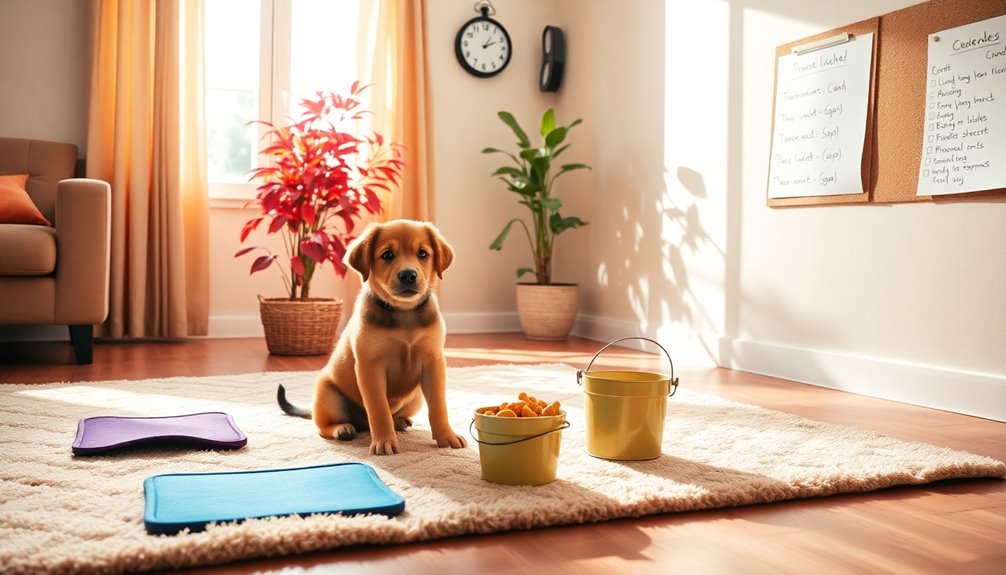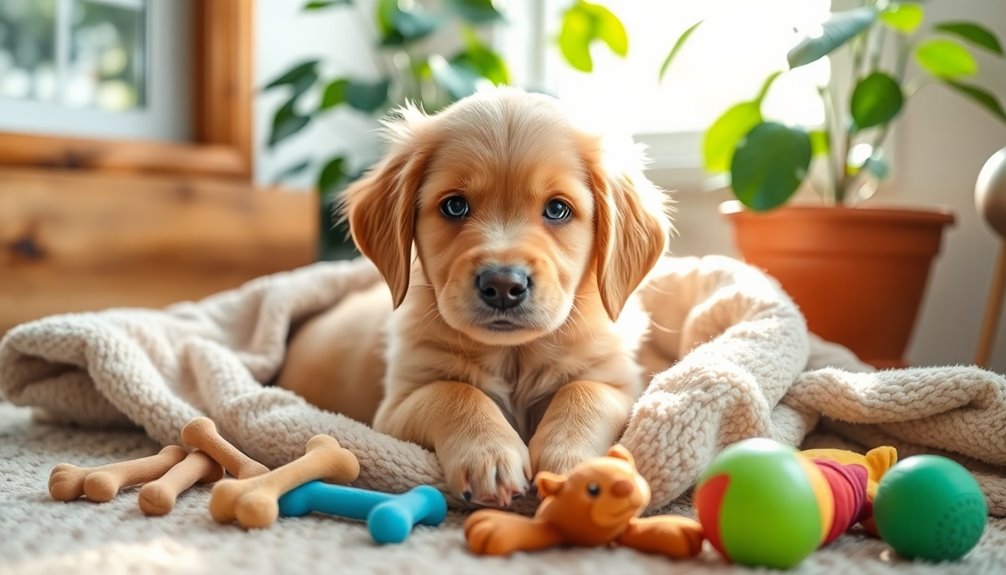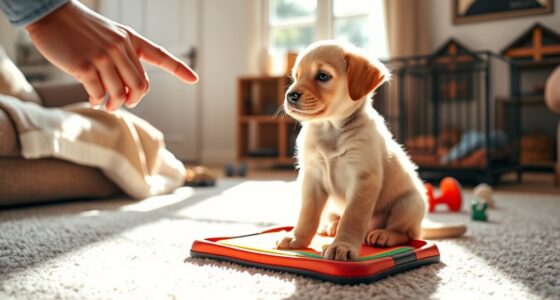To successfully house train your pet, start by understanding their signals and creating a supportive environment. Set a routine with scheduled bathroom breaks after meals and naps. Keep an eye out for signs of urgency, like sniffing or whining, and always use positive reinforcement when they go in the right spot. Make it fun by incorporating games or special treats, and encourage participation by involving your pet in the process. Also, remember that consistency is key, so stick to a plan. Stick around, and you'll discover even more effective strategies to make house training a breeze!
Key Takeaways
- Establish a consistent routine with scheduled bathroom breaks to reinforce habits and build confidence.
- Use positive reinforcement, such as treats or praise, to encourage desired behaviors during training.
- Create a fun and inviting potty area with decorations and accessories to inspire interest and reduce anxiety.
- Monitor your child for signs of needing the bathroom, like sniffing or circling, to prompt timely potty visits.
- Celebrate small successes and maintain open communication among caregivers to create a supportive training environment.
Understanding Potty Training Mindset
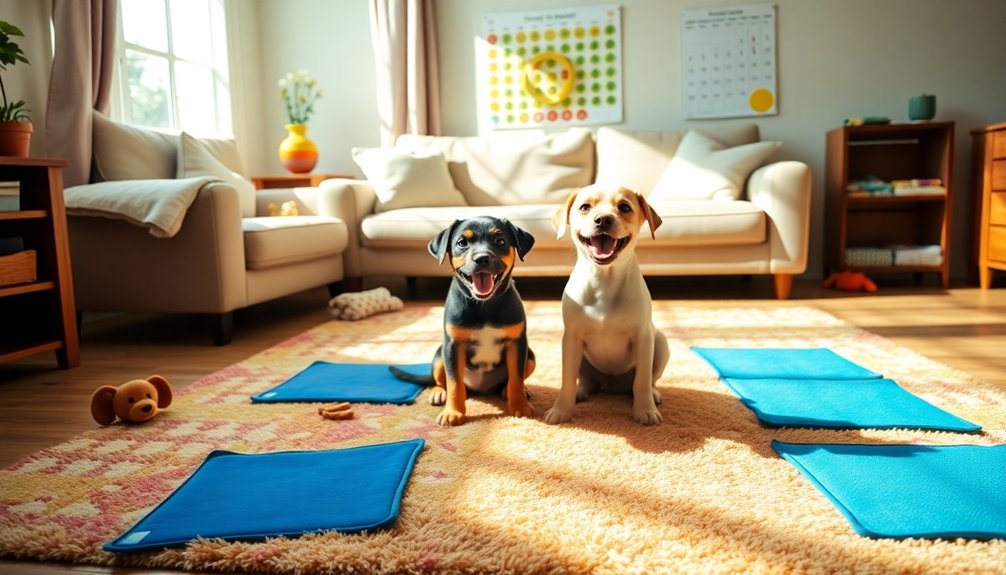
When it comes to potty training, adopting the right mindset is key to a smooth experience for both you and your child. The first step is recognizing that your child is ready when they show genuine interest in using the toilet. Forcing the process can create unnecessary stress, so it's important to stay relaxed and patient. A calm attitude helps foster independence, reducing control issues and allowing your child to explore their readiness without pressure.
Remember, accidents are a natural part of this learning journey. Instead of reacting negatively, maintain a positive mindset. This approach helps prevent feelings of shame and encourages your child to keep trying. Celebrate small successes along the way, whether it's a successful trip to the potty or simply expressing interest. These moments build confidence and reinforce a healthy attitude toward potty training.
Make the process potty training fun by incorporating games or rewards, turning what could be a stressful task into an enjoyable experience. Creating a positive environment not only supports your child's growth but also makes the journey smoother for both of you.
With patience and encouragement, you'll both thrive during this important milestone.
Effective Training Strategies
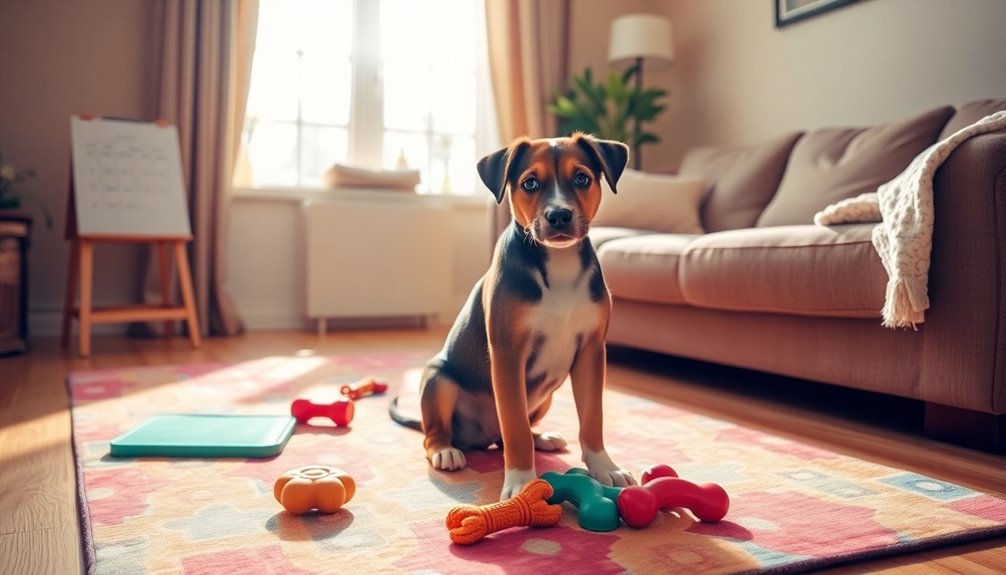
Establishing an effective training strategy is essential for successful potty training. By creating a routine, you can help your pet understand when it's time for bathroom breaks. Consistently take them out after meals and naps, as this reinforces the process.
Watch for signs that they need to go—sniffing, circling, or whining are key indicators. This monitoring can prevent accidents indoors and keep your training on track.
Utilizing positive reinforcement is vital. Immediately reward your pet with treats or praise after they go outside to build a positive association with bathroom behavior. It's also important to use designated potty areas consistently; this helps your pet learn where they should relieve themselves.
Here's a quick reference table to help you stay organized:
| Strategy | Description |
|---|---|
| Routine | Schedule bathroom breaks after meals and naps |
| Signs | Look for sniffing, circling, or whining |
| Positive Reinforcement | Reward with treats or praise right after they go outside |
As your pet shows consistent success, gradually extend the time between bathroom breaks to foster their confidence and independence in house training.
Fun and Engaging Techniques
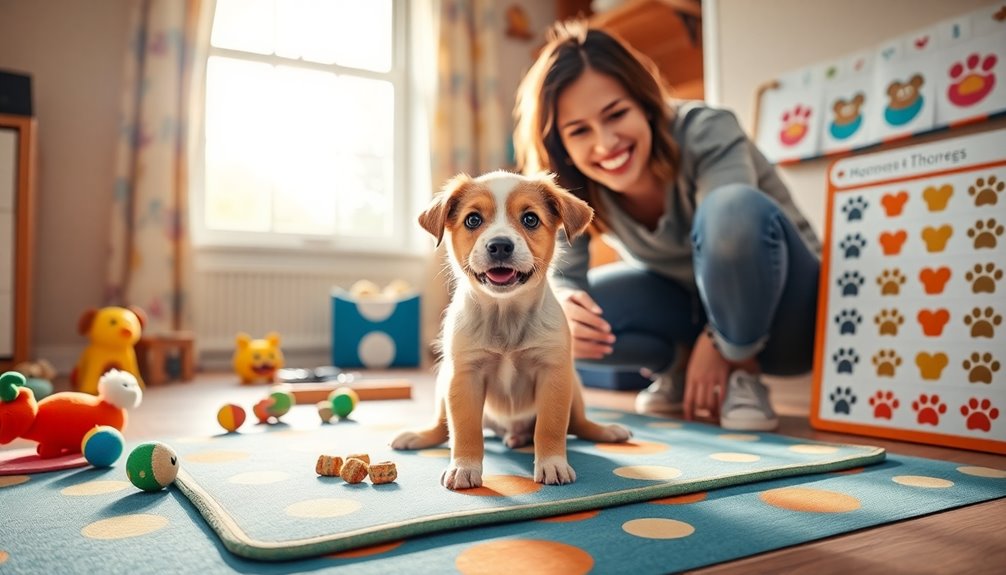
Potty training doesn't have to be a chore; it can actually be a fun and engaging experience for both you and your child. To make potty training enjoyable for your little ones, incorporate playful elements. For example, toss some Cheerios in the toilet and turn potty time into an aiming game. This simple trick encourages them to engage with the process while having a blast.
Consider using backward sitting on the potty. This technique helps prolong sitting time and eases anxiety, making your child feel more comfortable.
Creating a "Potty Fort" by setting up a cozy tent around the potty can also entice your child to use it without hesitation.
Humor plays a big role too. Introduce potty-themed songs or stories to enhance their interest and enjoyment during training.
Additionally, implement a reward system, like a Disney Rewards Chart, to visually track progress. Celebrate milestones with small treats, fostering motivation and excitement.
Recognizing Readiness Signs
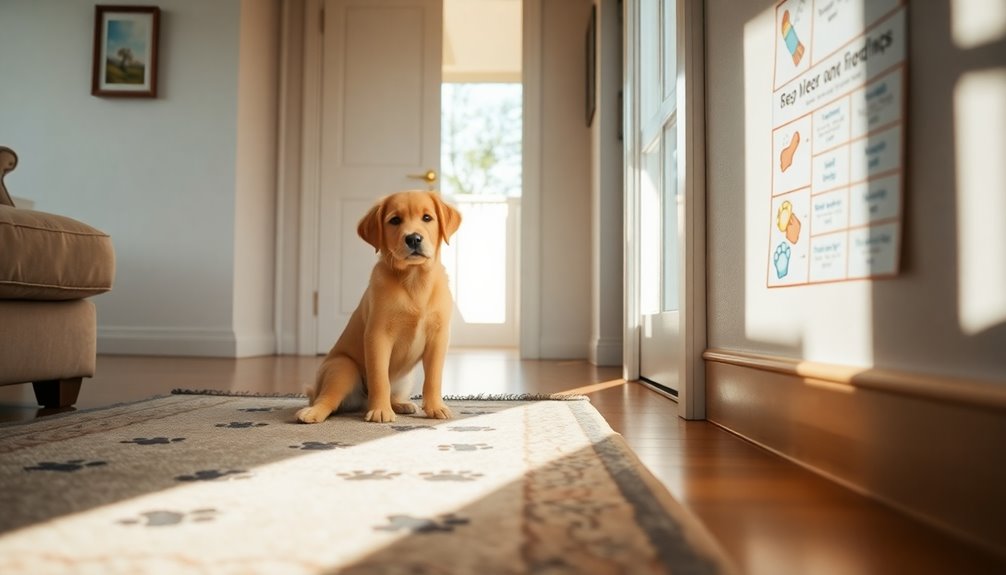
As you explore fun techniques for potty training, it's important to pay attention to your child's readiness signs. Recognizing these cues can make a significant difference in your training experience.
First, observe physical signs. If your child can stay dry for at least two hours or shows discomfort with a dirty diaper, they're likely ready to potty train. Emotional readiness is also key; look for signs like interest in the potty or a desire to be independent.
Communication skills matter too. Your child should be able to express their needs, whether verbally or through gestures, when they need to use the potty. Additionally, signs of maturity, such as the ability to follow simple instructions or an understanding of cause and effect, can indicate readiness.
Here's a quick reference table to summarize:
| Readiness Sign | Description |
|---|---|
| Physical Readiness | Stays dry for 2+ hours, discomfort with dirty diapers |
| Emotional Readiness | Interest in the potty, desire for independence |
| Communication Skills | Can express needs verbally or with gestures |
| Signs of Maturity | Follows simple instructions, understands cause and effect |
Waiting for genuine interest can lead to a smoother potty training journey.
Creating a Supportive Environment
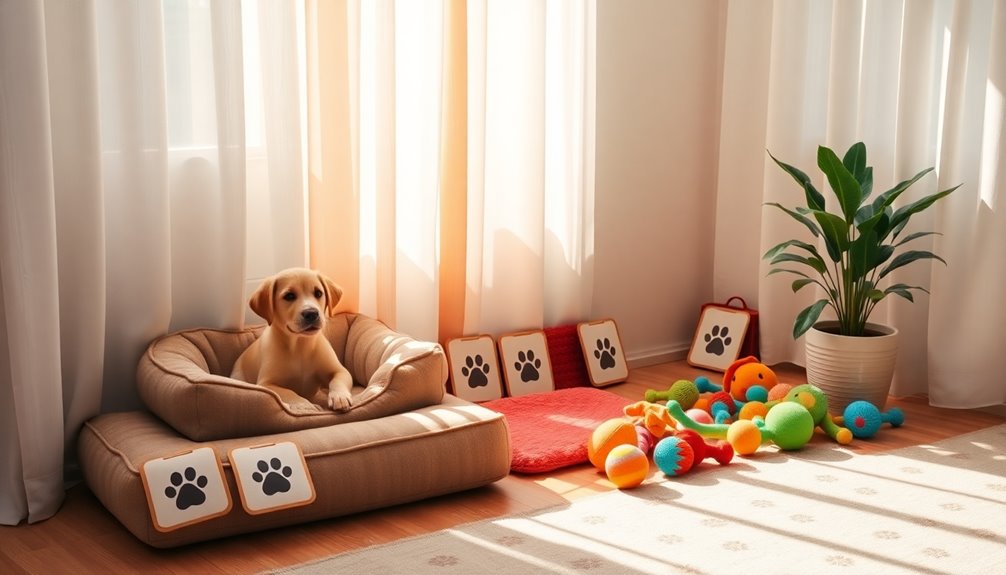
Creating a supportive environment during potty training can make all the difference in your child's experience. A relaxed atmosphere helps young children feel comfortable expressing their needs, reducing anxiety and promoting independence.
Set up a designated potty training area equipped with accessible supplies and familiar items, like favorite books or toys, to encourage engagement.
Consistent communication among all caregivers is essential. Make sure everyone is on the same page regarding routines and terminology. This consistency reinforces the training process, helping your child feel secure and understood as they navigate this new skill.
Celebrate small successes, like the first time using the potty or staying dry for a period. Acknowledging these milestones fosters a positive association with potty training and builds your child's confidence.
Utilize positive reinforcement techniques, such as praise or small rewards, to create an encouraging environment. This motivates your child to actively participate in their potty training journey.
Potty Training Incentives and Rewards
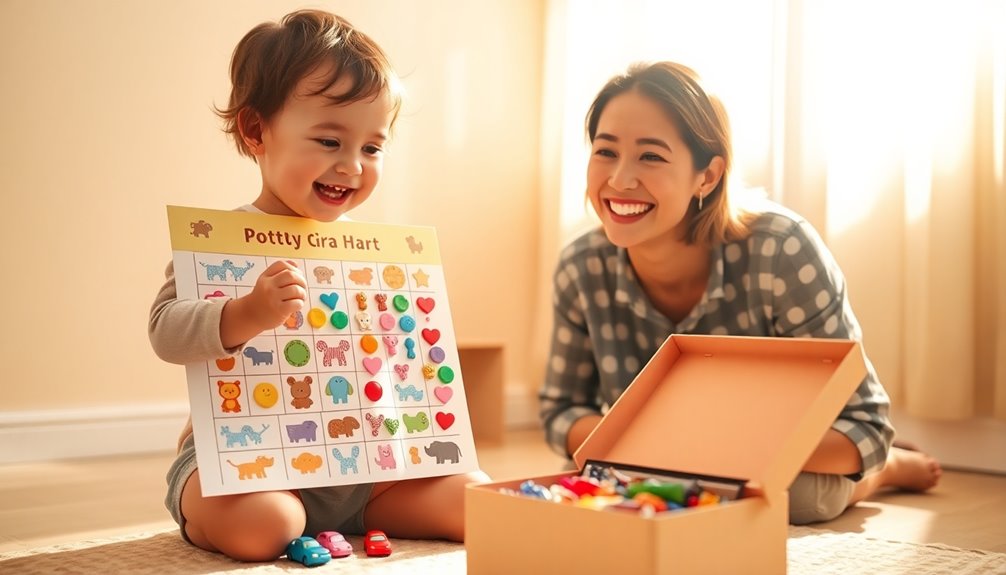
When it comes to potty training, using incentives and rewards can make the process more engaging for your child. Implementing a rewards system, like small treats such as Skittles or M&Ms, reinforces positive behavior and encourages participation. Every successful potty session deserves a little celebration!
To make progress visible, consider a visual tracking method like the Disney Rewards Chart. This allows your child to see their achievements, making milestones tangible and motivating them to continue.
Special bonding moments, such as spending one-on-one time with you after a successful attempt, can enhance their emotional investment in potty training.
Adding fun elements, like a squirt bottle for successful potty sessions, can create excitement around the process. It's all about making it enjoyable!
Also, identifying your child's unique Potty Personality can help tailor your potty training incentives effectively. Some children respond better to treats, while others thrive on praise or special activities.
Involving Your Child in the Process
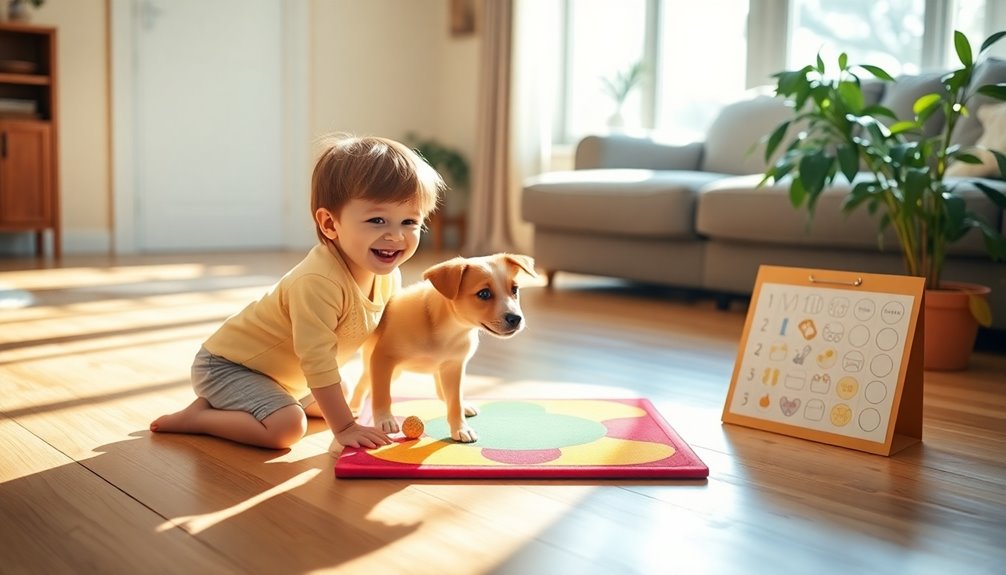
Getting your child involved in potty shopping can make the whole experience exciting for them.
Let them pick out their own potty and fun supplies like big-kid underwear, which can boost their motivation and sense of ownership.
Potty Shopping Together
Involving your child in the potty shopping process can change a seemingly mundane task into an exciting adventure. When you take your little one along, they get to choose their own potty, whether it features their favorite character or a color they love. This choice not only boosts their excitement but also gives them a sense of ownership over their potty training journey.
Treat the shopping trip as a fun reward for their participation. By framing it this way, you reinforce the idea that potty time can be enjoyable. As your child picks out their potty, they'll create a positive association with the whole process, making it easier for them to shift into potty training.
Moreover, this experience strengthens the parent-child bond. You'll share moments of anticipation and joy, making the journey feel like a team effort. As you navigate the aisles together, your little one will be more enthusiastic to engage in the training ahead, knowing they've played a part in choosing what they'll use.
Choosing Fun Supplies
Choosing fun supplies for potty training can greatly enhance your child's experience. Involving your child in the selection process not only fosters excitement but also gives them a sense of ownership. When you let them pick a potty chair or fun accessories, they become more engaged in their potty training journey.
Here's a quick guide to help you choose the right supplies:
| Item Type | Suggestions | Benefits |
|---|---|---|
| Potty Chair | Character-themed chairs | Increases willingness to use |
| Fun Accessories | Stickers, themed books | Makes training playful |
| Sticker Chart | Favorite characters | Motivates achievements |
| Designated Area | Colorful decorations, toys | Creates an inviting space |
Maintaining Consistency and Routine
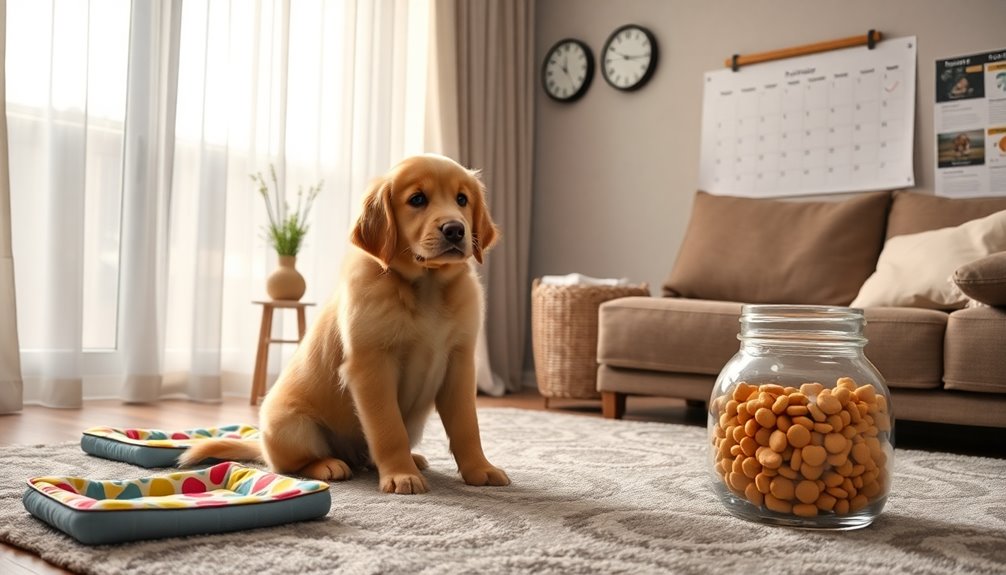
Establishing a consistent potty training routine is crucial for your child's success. By creating a reliable schedule, you help your child see when it's time to potty, which builds confidence and reduces accidents. Aim to take your child to the potty at regular intervals, like every two hours or after meals.
To maintain this consistency, consider these strategies:
- Reinforce routines: Use the same language and phrases when prompting your child. This familiarity helps ease anxiety about the process.
- Involve all caregivers: Verify everyone is on the same page regarding the potty training routine and expectations for maximum reinforcement.
- Adapt as needed: While maintaining core practices, be flexible and adjust your potty training routine to fit your child's unique needs and responses.
- Create a positive environment: Celebrate small victories and progress to motivate your child. Recognition fosters enthusiasm for learning.
Navigating Common Challenges

Even with a solid routine in place, you might encounter some common challenges during potty training. It's vital to remember that accidents during potty training are perfectly normal. To minimize these incidents, establish a consistent schedule by taking your child to the potty at regular intervals. This helps reinforce the habit and reduces frustration for both of you.
If your child seems resistant, approach the situation with patience and flexibility. Adjust your methods to better align with when your kids are ready. Utilize positive reinforcement strategies like reward charts or small treats to boost motivation and encourage your child to use the potty willingly.
Additionally, address any fears your child might have, whether it's the sound of flushing toilets or unfamiliar environments. Gradual exposure and reassurance can alleviate anxiety and smooth the shift to using the potty.
Lastly, communicate openly with all caregivers involved in the training process. Consistency is vital and having everyone on the same page guarantees your child feels supported, building their confidence and understanding throughout this journey.
Frequently Asked Questions
What Is the Most Successful Potty Training Method?
The most successful potty training method often revolves around your child's readiness.
Watch for signs of interest and independence before starting. Using positive reinforcement, like small treats or reward charts, can boost motivation.
Some parents find that going cold turkey, removing diapers entirely, creates urgency.
Engaging your child with fun activities, such as potty-themed games or books, can also make the process enjoyable and less stressful for both of you.
Consistency is key!
What Is the 10-10-10 Rule for Potty Training?
The 10-10-10 rule for potty training is a structured approach that can make the process smoother for you and your child.
You wait 10 minutes before taking your child to the potty, then let them sit for another 10 minutes, followed by a 10-minute break.
This method emphasizes patience and consistency, helping your child understand their bodily signals without feeling overwhelmed.
What Is the 3 Day Potty Training Trick?
Did you know that many parents see a 60-80% success rate with the 3 Day Potty Training Trick?
This intensive method requires you to commit a weekend solely to potty training. You'll remove all diapers and consistently take your child to the potty every 15-30 minutes.
Use positive reinforcement for successful attempts, and keep a supportive attitude, as consistency is essential.
What Is the Trick to Potty Training?
The trick to potty training lies in understanding your child's readiness and making the process fun.
Start by observing signs like staying dry for longer periods. Create a positive environment with colorful potty supplies and a consistent routine for bathroom breaks.
Use positive reinforcement, like treats or stickers, to celebrate successes. Encourage your child to choose their potty items, fostering ownership and interest in the training, making it an enjoyable experience for both of you.
Conclusion
In the journey of potty training, remember that patience is your greatest ally. With the right mindset and strategies, you'll transform this challenge into a shared adventure. By recognizing readiness signs and creating a supportive environment, you're laying the foundation for success. Keep the process engaging and consistent, and don't forget to celebrate those small victories. With dedication, you'll watch your little one bloom into independence, like a flower unfurling its petals in the warmth of the sun.

